Impact of Retro-Walking on Pain and Disability Parameters Among Chronic Osteoarthritis Knee Patients
Abhina M Balraj, Kamraj B, Rahul Krishnan Kutty* and Saji Vt
Department of Physiotherapy, Mekelle University, Mekelle, East Africa
Submission: April 11, 2018;Published: September 12, 2018
*Corresponding author: Rahul Krishnan Kutty, Assistant Professor, Department of Physiotherapy, School of Medicine, College of Health Sciences, Mekelle University, Mekelle, Ethiopia, East Africa, Email: physioraul@gmail.com
How to cite this article: Abhina M B, Kamraj B, Rahul K K,Saji V. Impact of Retro-Walking on Pain and Disability Parameters Among Chronic Osteoarthritis Knee Patients. J Yoga & Physio. 2018; 6(2): 555682. DOI:10.19080/JYP.2018.06.555682
Abstract
Osteoarthritis is a degenerative joint disease involving the cartilage and surrounding tissues. It results in damage and loss of articular cartilage, remodeling of subarticular bone, osteophyte formation, ligamentous laxity, weakening of periarticular muscles and synovial inflammation. Retro-walking is walking backwards [1]. Since there is propulsion in backward direction and reversal of leg movement in Retro-walking, different muscle activation patterns from those in forward walking are required [2]. Back ward walking increases stride rate decreases stride length and increases support time. Muscular structure supporting ankle and knee reversed their role during retro-walking.
Materials and methods: An Experimental study designs with random sampling methods was used. The total duration of study extended to 3months and study was done at Co- operative Institute of Health Science, Physiotherapy Department, Tellicherry, Kerala, India. All the samples participants were informed about the study and a written consent was obtained from each. Approval of the local ethical committee was also obtained. The study population include 30 patients with chronic OA knee with age group of 50-55 years. For this study both male and female were included. Also, inclusion criteria with knee pain more than 6 weeks, Bilateral and unilateral involvement, participants fulfilling three out of the six clinical criteria listed by The American College of Rheumatology were diagnosed as knee OA which was confirmed using radiological investigations. The criteria are Age>50 years, Morning stiffness lasting<30min, Crepitus with active motion, Bony tenderness, Bony enlargement and No warmth to touch and diagnosed to have chronic OA (Kellengren and Lawrence scale 3-4) were included in the study. Participants with balance problem, History of any lower extremity injury or underlying pathology, Systemic inflammatory disease, Osteoporosis, Post traumatic stiffness of knee and acute post-surgical knee cases were not included in the study.
Result: When comparing the post-test values of ROM &WOMAC in both control and experimental group through analysis of inter group significance: WOMAC shows sig value 0.002 in independent t-test (p<0.05) , calculated t value 3.436(>tabled t value 2.048 df=28), knee flexion ROM shows sig value 0.038(p<0.05) calculated t-value 2.289>tabled t value 2.048,df=28 at p=0.05 and Knee extension ROM sig value 0.025 (p<0.05), calculated value 2.82> tabled t value 2.048, df=28 at p=0.05. This shows that control group shows significant difference from experimental group in WOMAC and extension ROM, and flexion ROM. There is significant difference for Retro-walking and conventional treatment over conventional treatment alone in reducing pain& disability and improving ROM for patients with OA knee.
Conclusion: The study was to evaluate the effectiveness of Retro-walking for reducing pain and disability and improving range of motion in patients with chronic osteoarthritis. The subjects included were those who came to the outpatient clinic at CIHS. 30 subjects were randomly divided into Control Group and Experimental Group (15pts in each group). Control Group received conventional treatment alone and Experimental Group received conventional treatment and retro-walking. Both Group received treatment period of about 40-45min in each session for a regular period of 6 days in a week. The outcome measures used were standard goniometer and WOMAC, The measurement were taken prior to the treatment on the first day [pre-test value] and on the last day of treatment [post-test value]. Statistical analysis were done using paired t-test and Independent t-test. The result obtained revealed that both groups showed significant difference between their pre- test and post-test values but statistically, Experimental Group shows more significant difference than Control Group. Statistically it is observed that, retro-walking leads to a significant improvement in reduction of pain and disability of the subjects under study. Based on the performed study was concluded that the patients who undergone OA knee rehabilitation should undergo retro- walking in their rehabilitation protocol.
Keywords: Retro-walking; backward walking; physiotherapy; Osteoarthritis, Western Ontario and McMaster Universities Arthritis Index (WOMAC)
Introduction
Osteoarthritis is a degenerative joint disease involving the cartilage and surrounding tissues. It results in damage and loss of articular cartilage, remodeling of subarticular bone, osteophyte formation, ligamentous laxity, weakening of periarticular muscles and synovial inflammation [3]. The word “osteoarthritis‟ originated from the Greek word “osteo” meaning “of the bone”, “arthro” meaning “joint”, and “itis” meaning inflammation, although the “itis” of osteoarthritis is somewhat of a misnomer– inflammation is inconspicuous feature, it is present in rheumatoid or autoimmune types of arthritis [4]. OA is a non-inflammatory progressive disorder of movable joints, particularly weight bearing joints. American College of Rheumatology Diagnostic and Therapeutic Committee defined OA as, a heterogeneous group of conditions that lead to joint symptoms and signs which are associated with defective integrity of articular cartilage, in addition to relative changes in the underlying bone at the joint margins‟. The disease limits everyday activities, such as getting in and out of bed, dressing and climbing stairs [5]. Exact cause of OA is not known. However, it is strongly believed that it occurs due to aging or wear and tear or degenerative changes in the joints. Risk factors for OA knee includes age, gender, obesity, occupation, sports, osteoporosis, previous trauma, irregularity in joint surfaces, internal derangement, heredity, leisure and diseases leaving articular cartilage damage [4,5]. Osteoarthritis is a chronic, localized joint disease effecting approximately one-third of adult, with the disease prevalence increasing with advancing age [6] and generally affect women more frequently than men. The knee is the most common weight bearing joint affected by OA, with the disease predominantly affecting the medial compartment of the joint [7,8].
The world health organization approximates that several hundred million people currently suffer from bone and joint disease with significant increases predicted due to a doubling in a number of people over the age of 50 by 2010 [9]. The physical disability arising from knee OA prevents the performance of daily life activities and negatively affects life quality. Several factors play roles in the occurrence of physical disability. These include pain, joint movement restriction, muscle weakness, and coordination impairment [10]. In patients with knee OA, there is a prominent loss in proprioception compared with control subjects of the same age and gender [11]. It has been demonstrated that impaired proprioception adds to functional insufficiency by generating impairment in walking rhythm, shortening step distance, and a decrease in walking speed and total walking time [12].
Arthritis foundation of India has cited an interesting Chalo Chalein (come we will move) test that most of us can understand. Four simple questions are asked to the individual and if answer to any one is yes then there is possibility individual suffering from arthritis. These questions are: Is getting up from a seated position or standing for long period of time while cooking; a painful experience?, Are climbing stairs and attending prayer meetings being avoided? And is going for family outings becoming more and more difficult [4].
Retrowalking is sometimes referred to as backward walking, has been thought to be used already for several decades in China, Japan and Europe to get a physical workout, improve sport performance, promote balance and also to stay mentally fit [13]. Retro-walking is walking backwards [1]. Since there is propulsion in backward direction and reversal of leg movement in Retro-walking, different muscle activation patterns from those in forward walking are required [2]. Back ward walking increases stride rate decreases stride length and increases support time. Muscular structure supporting ankle and knee reversed their role during retro-walking. Backward walking produces significantly lower patellar compressive force than forward walking and helps to reduce maximal vertical force and impulsive force on knee in comparison to forward walking because of Toe heel contact pattern. Retro-walking is associated with increased cadence, decreased stride length and different joint kinematics as compared to forward walking and hence may offer some benefits over forward walking alone [14,15]. In fact in Europe, they have races which vary from sprints to the 26.2 miles marathon. Barry Bates and Janet Dufek at the University of Oregon started to investigate backward walking in mid-1980s. They suggested that retrowalking provided unique training and rehabilitative benefits. Recently, closed kinematic chain exercises have drawn much attention in the management of knee OA. Closed kinematic chain exercises for knee joint can be incorporated in many ways, one of them is retrowalking [16]. A gait cycle during retrowalking can be defined as toe-on of a limb to the subsequent toe-on of the same limb. Retrowalking significantly lowers peak patellofemoral joint compressive force and a significantly slower rate of loading has been found during backward walking. Consequently, trauma to the articular cartilage is reduced during retrowalking; therefore, it could be used as a mode of training after sustaining injuries to the lower limb. Retrowalking could be an effective tool to increase quadriceps strength after immobilization or surgery since the quadriceps is activated for a longer period. Retrowalking could be utilized as a mode of training during knee rehabilitation since excessive loading of the joint and overstretching of the ligaments are prevented whilst quadriceps strength [17].
Since we have very less evidences regarding the functional rehabilitation of patients with degenerative diseases around the knee joint. Considering the advantageous effect of retro-walking with respect to forward walking in decreasing the compressive load on knee and improvising the muscular strength. In this study, aim is to find out the effectiveness of Retro -Walking training to overcome pain and physical dysfunction in patients suffering from chronic O.A knee.
Materials and Methods
The study population include 30 patients with chronic OA knee with age group of 50-55years. For this study both male and female were included and also inclusion criteria with knee pain more than 6 weeks, Bilateral and unilateral involvement, participants fulfilling three out of the six clinical criteria listed by The American College of Rheumatology were diagnosed as knee OA which was confirmed using radiological investigations [18]. The criteria are Age>50 years, Morning stiffness lasting<30 min, Crepitus with active motion, Bony tenderness, Bony enlargement and No warmth to touch and diagnosed to have chronic OA (Kellengren and Lawrence scale 3-4) were included in the study. Participants with balance problem, History of any lower extremity injury or underlying pathology, Systemic inflammatory disease, Osteoporosis, Post traumatic stiffness of knee and acute post-surgical knee cases were not included in the study.
An Experimental study designs with random sampling methods was used. The total duration of study extended to 3months and study was done at Co- operative Institute of Health Science, Physiotherapy Department, Tellicherry, Kerala, India. All the samples participants were informed about the study and a written consent was obtained from each. Approval of the local ethical committee was also obtained.
Outcome measures used in this study are Western Ontario and McMaster Universities Arthritis Index (WOMAC) and Goniometer. WOMAC is used to assess pain, stiffness and physical function levels in the subjects. It measures five items for pain, two for stiffness, and 17 for functional limitation. Physical functioning questions cover activities of daily living [19]. Universal Goniometer was used to assess knee joint ROM in prone position.
Among the 30 subjects they are divided into 2 groups in which Group A (Control) and Group B (Experimental). Informed consent was obtained from each subject prior to participation. A brief description about the procedure is given to the subjects before commencing the study. A total of 30 subject were divided equally into two groups by random sampling method, Group A (n=15) & Group B (n=15). Group A received conventional treatment and Group B received a combination of Conventional exercise and Retro-walking in treadmill which includes the experimental therapy. The treatment duration was 45 min in each session for a regular period of 6 days in a week. Both group received hot pack for 10min prior to exercise in order to warm up the muscle. Pre-test values were taken on the first day & the post-test values were taken after the total study duration of 3 weeks.
Group A received conventional treatment and Group B received a combination of Conventional exercise and Retrowalking in treadmill which includes the experimental therapy. The treatment duration was 45 min in each session for a regular period of 6 days in a week. Both group received hot pack for 10 min prior to exercise in order to warm up the muscle. Pre-test values were taken on the first day & the post-test values were taken after the total study duration of 3 weeks.
Data Analysis
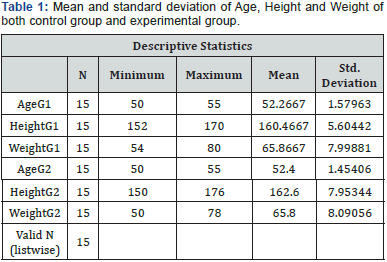
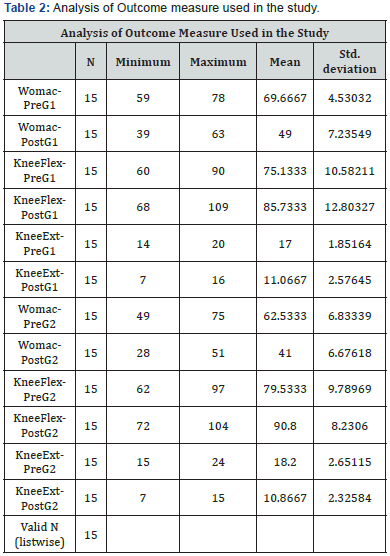
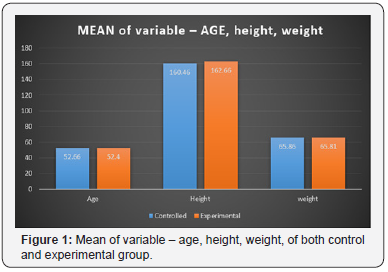
The 20.0 version of the Statistical Package for Social Science (SPSS) for Windows computer program was used for statistical analysis. The Student t-test was used to evaluate dependent and independent parametric variables, whereas the Mann-Whitney U test was used for nonparametric variables; the level of significance was accepted as P _ 0.05 (Table 1 & 2) (Figure 1-4).
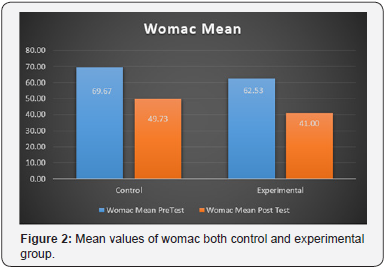
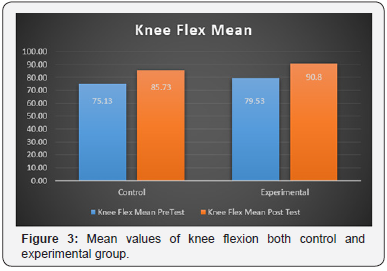
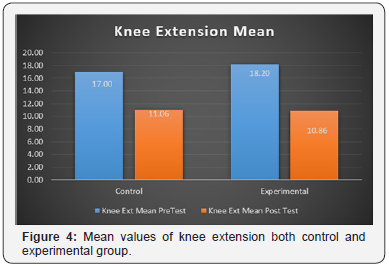
Results
Analysis of descriptive data
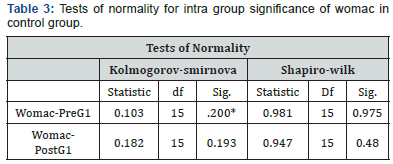
From the above (Table 3), it is evident that sig.value is >0.05, so paired t-test can be used to analyses the intra-group significance of Womac of control group.

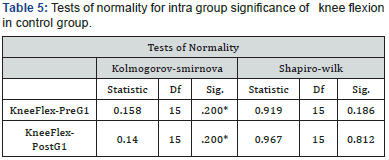
From the above (Table 4) through paired t-test, it is evident that calculated value t=14.915 (sig0.000) which is greater than the table value t=2.145(df=14 at p=0.05), which indicates that there is significant difference between the pre test and post test values of WOMAC in control group.
From the above (Table 5), it is evident that sig.value is >0.05, so paired t-test can be used to analyse the intra-group significance of Knee flexion of control group.

From the above (Table 6) through paired t-test, it is evident that calculated value t= 7.789(absolute value) (sig0.000) which is greater than the table value t= 2.145(df=14 at p=0.05), which indicates that there is significant difference between the pre test and post test values of knee flexion in the control group.
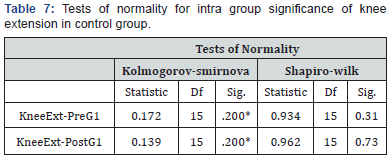
From the above (Table 7), it is evident that sig.value is >0.05, so paired t-test can be used to analyse the intra-group significance of knee extension of control group.
From the above (Table 8), through paired t-test, it is evident that calculated value t= 9.803 (sig 0.000) which is greater than the table value t=2.145(df=14 at p=0.05), which indicates that there is significant difference between the pretest and posttest values of knee extension in the control group.

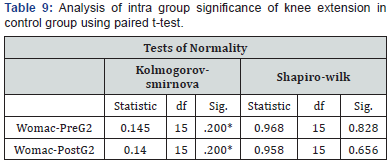
From the above (Table 9), it is evident that sig.value is >0.05, so paired t-test can be used to analyse the intra-group significance of womac of experimental group.
From the above (Table 10), through paired t-test, it is evident that calculated value t= 10.598 (sig0.000) which is greater than the table value t= -2.145(df=14 at p=0.05), which indicates that there is significant difference between the pretest and posttest values of WOMAC in the experimental group.

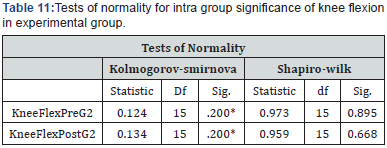
From the above (Table 11), it is evident that sig.value is >0.05, so paired t-test can be used to analyse the intra-group significance of Knee flexion of experimental group.
From the above (Table 12), through paired t-test, it is evident that calculated value t= 7.60875 (absolute value) (sig0.000) which is greater than the table value t=2.145(df=14 at p=0.05), which indicates that there is significant difference between the pre test and post test values of knee flexion in the experimental group.

From the above (Table 13), through paired t-test, it is evident that calculated value t = 10.258 (sig0.000) which is greater than the table value t=2.145(df=14 at p=0.05), which indicates that there is significant difference between the pre test and post test values of knee extension in the experimental group.
From the above (Table 14), through independent sample t-test, it is evident that significant value 0.002 which is less than probability value p=0.05 and calculated t-value=3.436 which is greater than table value t=2.048(df =28); which indicates that there is statistical significant difference between the post test values of WOMAC in the experimental group and control group.

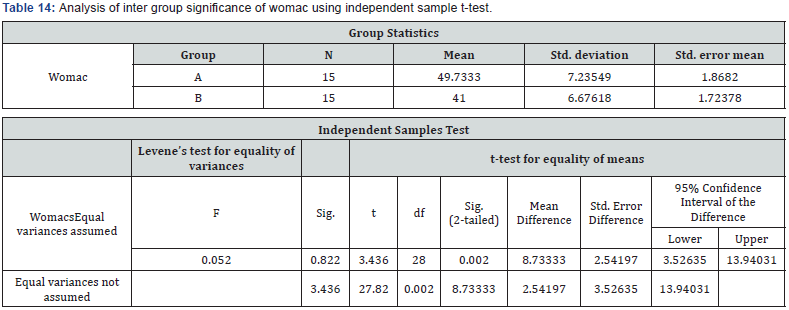
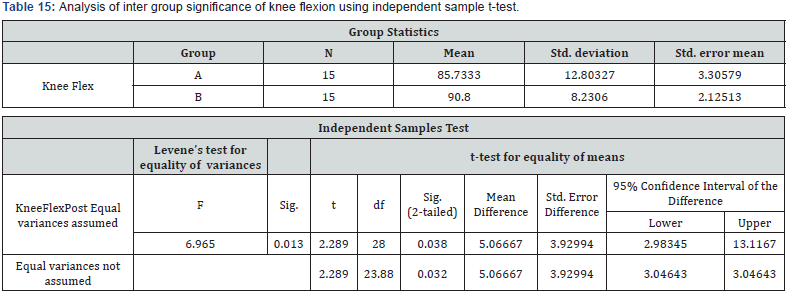
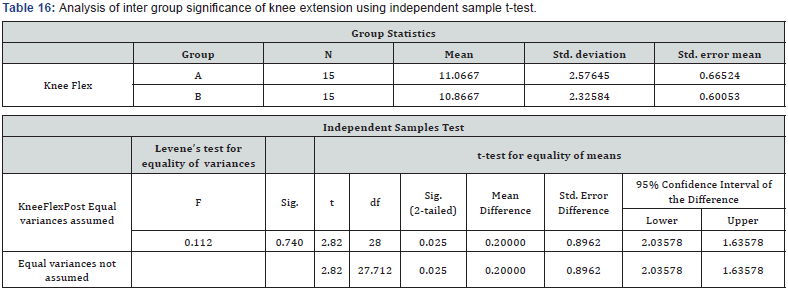
From the above (Table 15), through independent sample t-test, it is evident that significant value 0.038 which is less than probability value p=0.05 and calculated t-value=2.289 which is greater than table value t=2.048(df =28); which indicates that there is statistical significant difference between the post test values.
From the above (Table 16), through independent sample t-test, it is evident that significant value 0.025 which is less than probability value p=0.05 and calculated t-value=2.82 which is greater than table value t=2.048(df =28); which indicates that there is statistical significant difference between the post test values of knee extension in the experimental group and control group.
Findings in Control Group
Evaluation of WOMAC
By comparing the mean value of pre-test and post-test values of WOMAC, mean post test value of WOMAC is 49.00 which is less than the pre test value ie; 69.66 which indicates that there is significant decrease in WOMAC. Also, by analyzing the pretest and post-test values by paired t test, the calculated t value is 14.915 which is greater than table value t=2.145(df=14 at p=.05) which indicate that there is significant difference between pretest and post- test values of WOMAC.
Evaluation of knee flexion ROM
By comparing the mean value of pre-test and post-test values of knee flexion ROM, mean post test value is 85.7 Which is greater than the pre-test value 75.13, which indicates that there is significant difference between pre-test and post-test values of knee flexion ROM. Also, by analyzing the pre-test and posttest values by paired t test, the calculated t value is7.789 which is greater than table value t=2.145 which indicate that there is significant difference between the pre test and post test values of knee flexion ROM.
Evaluation of knee extension ROM
By comparing the mean value of pre-test and post-test values of knee extension ROM, mean pre-test value is 17 and mean post-test value was 11.06 which indicates that there is significant difference between the pre-test and post-test value of knee extension ROM .Also by analyzing the pre-test and post-test values through paired t test ,the calculated table value is 9.803 which is greater than table value t=2.145(df=14 at p=.05) Which indicate that there is significant difference between pre- test and post-test values of knee extension ROM.
Findings in Experimental Group
Evaluation of WOMAC
By comparing the mean value of pre-test and post-test values of WOMAC mean post-test value of WOMAC is 41.000 which is less than the pre-test value ie 62.5333 which indicates that there is significant decrease in WOMAC. Also, by analyzing the pre-test and post-test values by paired t test calculated t value is 10.598 which is greater than table t value 2.145 which indicate that there is significant difference between pre-test and post-test values of WOMAC.
Evaluation of knee flexion ROM
By comparing the mean value of pre-test and post-test values of knee flexion ROM, mean post test value is 90.80 Which is greater than the pre-test value 79.53, which indicates that there is significant difference between pre-test and post-test values of knee flexion ROM. Also, by analyzing the pre-test and post-test values by paired t test, the calculated t value is 7.60875 which is greater than table value 2.145 which indicate that there is significant difference between the pre-test and post-test values of knee flexion ROM.
Evaluation of knee extension ROM
By comparing the mean value of pre-test and post-test values of knee extension ROM, mean pre-test value is18.20 and mean post-test value is 10.86 which indicates that there is significant difference between the pre-test and post-test value of knee extension ROM .Also by analyzing the pre-test and post-test values through paired t test ,the calculated table value t=10.258 Which is greater than table value t=2.145(df=14 at p=.05), which indicate that there is significant difference between pre-test and pos- test values of knee extension ROM
When comparing the post-test values of ROM &WOMAC in both control and experimental group through analysis of inter group significance: WOMAC shows sig value 0.002 in independent t-test (p<0.05), calculated t value 3.436(>tabled t value 2.048 df=28), knee flexion ROM shows sig value 0.038(p<0.05) calculated t-value 2.289>tabled t value 2.048,df=28 at p=0.05 and Knee extension ROM sig value 0.025 (p<0.05), calculated value 2.82> tabled t value 2.048, df=28 at p=0.05. This shows that control group shows significant difference from experimental group in WOMAC and extension ROM and flexion ROM. There is significant difference for Retro-walking and conventional treatment over conventional treatment alone in reducing pain& disability and improving ROM for patients with OA knee.
Discussion
The purpose of the study was to find out the effectiveness of retro-walking on reducing pain and disability and improving ROM in patients with chronic OA knee. Osteoarthritis is a chronic, localized joint disease affecting approximately onethird of adult, with the disease prevalence increase with age. In this study, subject with knee pain were taken into consideration. From a large number of subjects with knee pain are selected by the proper screening and fulfilling the inclusion and exclusion criteria, 30 patients were diagnosed with pain and knee ROM deficit and divided into two group-control group and experimental group. (15 patients in each group). Control group received conventional exercise and experimental group received a combination of Conventional exercise and Retro walking. The treatment duration was 45min in each session for a regular period of 6 days in a week. Both groups received hot pack for 10min prior to exercise in order to warm up the muscle. Statistical data revealed that retro-walking along with conventional exercise shows significant effect over conventional exercise alone on reducing pain and disability.
Individual with OA knee walked more slowly, with less knee excursion, increased adduction moment and with more joint stiffness. These secondary compensatory gait adaptation in OA knee patients helps in reducing pain by decreasing ground reaction loading on knee. This prolonged usage of secondary gait compensation creates greater imbalance of muscle, progressively reduces muscle strength, endurance, flexibility and later ending to deformity [20]. During forward walking knee joint flexes, extends and then flexes in support phase, where as in backward walking knee initially extends, flexes and extends in support phase, prior to flexing and extending during swing. However, support swing ratio of retro-walking is similar to forward walking with 60% support and 40% swing.
Muscular structure supporting ankle and knee reversed their role during retro-walking (In, retro-walking knee provides the primary power producer (co-contraction of hamstring and quadriceps) and ankle plantar flexors as shock absorber). Direction of knee joint shear force directed forward initially during retro-walking whereas backward in forward walking. Retro-walking produce significantly lower patellar compressive force than forward walking. Retro-walking helps to reduce maximal vertical force and impulsive force on knee compare to forward walking because of toe-heel contact pattern [21]. Knee OA is a prevalent condition contributing significantly to functional limitation and disability. Secondary gait change pattern of OA is due to pain, decreased muscle strength, instability and stiffness. Numerous studies revealed pain in OA knee is due to increased abnormal ground reaction force loading on joint and decreased extensor moment [19].
Kinetic and kinematic variable in knee joint of O.A. include, decreased knee flexion angle, decreased knee extension moment, increased hip extension moment at the beginning of single leg stance and decreased flexion momentum at the end of single leg stance. There will be increased in leg stiffness adaption at the end of single leg stance to gain stability while accepting body weight. This adaptation gradually increases stiffness of knee joint, increases extension lag and reduces their balance. The results showed significant improvement in all parameter following Retro walking intervention, shows normalizing kinetic and kinematic variable [20]. Retro‑walking is highly effective in reducing pain and extension lag and improving physical function and dynamic balance in knee OA patients [21]. In another study it was concluded that retro‑walking is an effective adjunct to conventional treatment in decreasing disability in patients with knee OA [22]. In this study, strengthening exercises for hip and knee helping to steady the knee and give additional joint protection from shock and stress. In addition to this, Retro-walking may have effect on pain relief by reducing excess adductor moment at knee joint decreasing the compressive forces on medial compartment of knee joint, which is in contrast with a study that demonstrated, addition of kinesthesia and balance exercises that help neuromuscular restoration to standard strengthening exercises provides dynamic muscle strength increase with significant recoveries in the functional status of the patients [23].
On statistical analysis, the mean pre-treatment WOMAC of control group and experimental group is 69.66%and 62.53% and mean post-treatment WOMAC is 49.00%and 41.00% respectively. This result shows that there is an increase of 21.53% in experimental group and20.66 % in the control group; which indicates that there is considerable decrease in WOMAC in experimental group patients with OA knee. In a study on the effectiveness of retro walking in chronic osteoarthritis of knee joint. He found that retro-walking showed improvement in WOMAC index, extension lag and dynamic balance which occurred due to its greater impact in increasing extension moment improvising strength in functional range with decline compression force which assist in improving physical function [24].
The mean pre-treatment knee flexion ROM of control group and experimental group is 75.13% and 79.53%, and mean post treatment ROM is 85.73% and 90.80% respectively. This result shows that there is a increase of 11.26% in experimental group and 10.6% in control group which indicate that there is considerable decrease of pain and increase in ROM in experimental group patients with OA knee. The mean pretreatment knee extension ROM of control and experimental group is 17.00% and 18.20%, and mean post treatment ROM is 11.06% and 10.86% respectively. This result shows that there is a increase of 7.33% in experimental group and %5.93 in control group which indicate that there is considerable decrease of pain and increase in ROM in experimental group patients with OA knee.
Statistically, significant improvement in function is seen in both the groups and between the groups. However, the improvement in experimental group is greater than that of control group. Improvement in function may be attributed to the reduction of pain, reduction in abnormal joint kinetics and kinematics during functional movements and improved muscle activation pattern. In another study the improvement in the physical mobility can be attributed to retrowalking as well as conventional physiotherapy treatment. In their study on effectiveness of retrowalking treadmill on osteoarthritis of knee and found significant improvement in the mobility after 3 weeks of intervention [25]. Also, a study proves that both forward and backward lead to a reduction of pain and improvement of physical function and QOL. This may eventually lead to a lessened burden of life and the individual can perform his ADLs without any complaints [26,27].
As advantages of Retro-walking include improvement in muscle activation pattern, reduction in adductor moment at knee during stance phase of gait and augmented stretch of hamstring muscle groups during the stride; all of these may have helped in reducing disability thus leading to improved function [28]. There is a possibility that proprioceptive and balance training may have occurred during Retro-walking adding to its benefits. Retro-walking also has effect on improving strength of hip extensors leading to reduced hip flexion moment during stance phase and thus preventing abnormal loading at knee joint and, in turn, the disability [29]. As a result of exercises and Retrowalking there was improvement in the strength of muscles at knee and hip which may have reduced functional disability [30]. Hence, the study concludes retro-walking is effective in reducing symptom and overcoming physical dysfunction in osteoarthritis of knee.
Conclusion
The study was to evaluate the effectiveness of Retrowalking for reducing pain and disability and improving range of motion in patients with chronic osteoarthritis [31]. The subjects included were those who came to the outpatient clinic at CIHS. 30 subjects were randomly divided into Control Group and Experimental Group (15pts in each group). Control Group received conventional treatment alone and Experimental Group received conventional treatment and retro-walking [32]. Both Group received treatment period of about 40-45min in each session for a regular period of 6 days in a week. The outcome measures used were standard goniometer and WOMAC, The measurement were taken prior to the treatment on the first day (pre-test value) and on the last day of treatment (post-test value) [33]. Statistical analysis were done using paired t-test and Independent t-test. The result obtained revealed that both group showed significant difference between their pre- test and posttest values but statistically, Experimental Group shows more significant difference than Control Group [34]. Statistically it is observed that, retro-walking leads to a significant improvement in reduction of pain and disability of the subjects under study. Based on the performed study was concluded that the patients who undergone OA knee rehabilitation should undergo retrowalking in their rehabilitation protocol [35].
The study was conducted on a small sample size which might affect the generalization of results. Limited parameters of outcome measures were used and Duration of study was less. All measurements were taken manually and this may introduce human error which could affect the reliability of the study.
References
- Pradeep Shankar, Renukadevi M, Adithi Bhandiwad, Harish Pai (2013) Effectiveness of retro-walking in chronic osteoarthritis of knee. Innovative Journal of Medical and Health Science 3(1): 19-22.
- Sami S Alabdelwahab, Shaji John (2010) Efficacy of retrowalking on strength and balance in patients with hamstring strain Br J Sports Med 44(1).
- Ledingham J, Regan M, Jones A, Doherty M (1993) Radiographic patterns and associations of osteoarthritis of the knee in patients referred to hospital. Ann Rheum Dis 52(7): 520-526.
- Iorio R, Healy WL (2003) Unicompartmental arthritis of the knee. J Bone Joint Surg Am 85-A(7): 1351-1364.
- 'Osteoarthritis fact sheet’ (2005) Arthritis foundation.
- Nor AM, Lyn KS (2011) Effects of passive joint mobilization on patients with -knee osteoarthritis’. Sains Malays 40: 1461–1465.
- Kumar TR, Ashraf M (2009) The effect of backward walking treadmill training on kinematics of the trunk and lower limbs. Serb J Sports Sci 3: 121–127.
- Chen LY, Su FC, Chiang PY (2000) Kinematic and EMG analysis of backward walking on treadmill. Conf Proc IEEE Eng Med Biol Soc 2: 825–827.
- Cipriani DJ, Armstrong CW, Gaul S (1995) Backward walking at three levels of treadmill inclination: An electromyographic and kinematic analysis. J Orthop Sports Phys Ther 22(3): 95–102.
- McConnell S, Kolopack P, Davis AM (2001) The Western Ontario and McMaster Universities Osteoarthritis Index (WOMAC): A review of its utility and measurement properties. Arthritis Rheum 45(5): 453-461.
- Anna Litwic, Mark Edwards, Elaine Dennison, Cyrus Cooper (2013) Epidemiology and Burden of Osteoarthritis Br Med Bull 105: 185-199.
- Nasim Foroughi, Richard Smith, Benedicte Vanwanseele The association of external knee adduction moment with biomechanical variables in osteoarthritis. Discipline of Exercise, Health and Performance, Faculty of Health Sciences, University of Sydney, Sydney, Australia.
- Shreyasee Amin, Niyom Luepongsak, Chris A McGibbon, Michael P La Valley, David E Krebs Knee adduction moment and development of chronic knee pain in elders.
- Khyatee, Kanchan Mittal, SK Gupta (2013) Retro-walking as a rehab illative tool in knee pain and quadriceps insufficiency. 2(4).
- Gondhalekar GA, Deo MV (2013) Effects of Retro-walking over conventional treatment on pain and disability in patients with acute exacerbation of chronic knee osteoarthritis. N Am J Med Sci 5(2): 108- 112.
- Chet R Whitley, Janet S Dufek Effects of Backward Walking on Hamstring Flexibility and Low Back Range of Motion. Arizona School of Health Sciences Department of Physician Assistant Studies AT. Still University, Mesa, AZ, USA. Biomechanics Laboratory Sports Injury Research Center, Department of Kinesiology and Nutrition Sciences, University of Nevada, Las Vegas, USA.
- Bischoff HA, Roos EM (2003) Effectiveness and safety of strengthening, aerobic, and coordination exercises for patients with osteoarthritis. Curr Opin Rheumatol 15(2): 141-144.
- Bennell KL, Ahamed Y, Jull G, Bryant C, Hunt MA (2015) Physical therapist-delivered pain coping skills training and exercise for knee osteoarthritis. American College of Rheumatology.
- Jun Iwamoto, Yoshihiro Sato, Tsuyoshi Takeda, Hideo Matsumoto (2011) Effectiveness of exercise for osteoarthritis of the knee: A review of the literature. World J Orthop 2(5): 37–42.
- Al-Johani AH, Kachanathu SJ, Ramadan Hafez A, Al-Ahaideb A, Algarni AD, et al. (2014) Comparative Study of Hamstring and Quadriceps Strengthening Treatments in the Management of Knee Osteoarthritis. J PhysTher Sci 26(6): 817-820.
- Van der Esch M, Holla JF, Van der Leeden M, Knol DL, Lems WF, et al. (2014) Decrease of muscle strength is associated with increase of activity limitations in early knee osteoarthritis. Arch Phys Med Rehabil 95(10): 1962-1968.
- Veronese N, Maggi S, Trevisan C, Noale M, De Rui M, et al. (2017) Pain increases the risk of developing frailty in older adults with osteoarthritis. Pain Med 18(3): 414-427.
- Kudo M, Watanabe K, Otsubo H, Kamiya T, Kaneko F, et al. (2013) Analysis of effectiveness of therapeutic exercise for knee osteoarthritis and possible factors affecting outcome. J Orthop Sci 18(6): 932-939.
- Fitzgerald GK, Fritz JM, Childs JD, Brennan GP, Talisa V (2016) Exercise, manual therapy, and use of booster sessions in physical therapy for knee osteoarthritis. Osteoarthritis Cartilage 24(8): 1340-1349.
- Chen Y, Yu Y, He CQ (2015) Correlations Between Joint Proprioception, Muscle Strength, and Functional Ability in Patients with Knee Osteoarthritis. Sichuan Da Xue Xue Bao Yi Xue Ban 46(6): 880-884.
- Kraus VB, Vail TP, Worrell T, McDaniel G (2005) A comparative assessment of alignment angle of the knee by radiographic and physical examination methods. Arthritis Rheum 52(6): 1730-1735.
- Holla JF, Steultjens MP, van der Leeden M, Roorda LD, Bierma-Zeinstra SM, et al. (2011) Determinants of range of joint motion in patients with early symptomatic osteoarthritis of the hip and/or knee. Osteoarthritis Cartilage 19(4): 411-419.
- Hutton CW (1989) Osteoarthritis: the cause not results of joint failure? Ann Rheum Dis 48(11): 958-961.
- Felson DT, Naimark A, Anderson J, Kazis L, Castelli W, et al. (1987) The revalance of knee osteoarthritis in the elderly. The Framingham Osteoarthritis Study. Arthritis and Rheumatism 30: 914-918.
- Yildirim N, Filiz Ulusoy M, Bodur H (2010) The effect of heat application on pain, stiffness, physical function and quality of life in patients with knee osteoarthritis. J Clin Nurs 19(7-8): 1113-1120.
- Gill SV, Hicks GE, Zhang Y, Niu J, Apovian CM, et al. (2017) The association of waist circumference with walking difficulty among adults with or at risk of knee osteoarthritis initiative. Osteoarthritis cartilage 25(1): 60-66.
- Gurer G, Bozbas GT, Tuncer T, Unubol Al, Ucar UG, et al. (2016) Frequency of joint hypermobility in turkish patients with knee osteoarthritis. Int J Rheum Dis doi: 10.1111/1756-185X.12883.
- Helminen EE, Sinikallio SH, Valjakka AL, Vaisanen- Rouvali RH, Arokoski JP (2016) Determinants of pain and functioning in knee osteoarthritis. Clin Rehabil 30(9): 890-900.
- Ojoawo AO, Olaogun MO, Hassan MA (2016) Comparative effects of proprioceptive and isometric exercise on pain and difficulty in patients with knee osteoarthritis: A randomized control study. Technol Health Care 24(6): 853-863.
- Iversen MD, Price LL, von Heideken J, Harvey WF, Wang C (2016) Physical examination findings and their relationship with performancebased function in adult with knee osteoarthritis. BMC musculoskeletal disorder 17: 243.






























